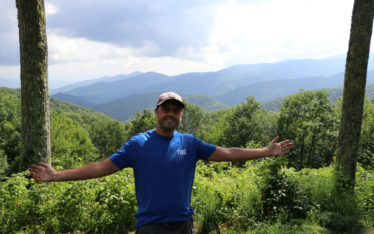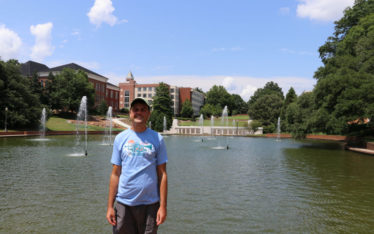Leaving New Orleans we were on the move once again. We had a great time in New Orleans and its big city charms but it was time to get back to our normal routes; two lane roads and the small towns that dot them. Today we would be heading into a new state, Mississippi, our 38th state visited. The road north from New Orleans to Baton Rouge and beyond quickly transitioned from causeways over swampy Cyprus tree filled areas to small rolling green hills filled with Oak and Magnolia trees. We drove north along route 61 through the remaining part of Louisiana until we crossed over into Mississippi.
Almost immediately after crossing the border we started to see old plantation homes of the Antebellum era. These were beautiful old homes set back on plantations that looked just like something out of a movie with huge oak and magnolia tree’s surrounding them. While we were not able to stop at any of them it was pretty neat to see nonetheless.
Our stop for the day was the small but historic town of Natchez. Natchez is an old and historically significant town. Founded by the French in 1716 it was an important center for trade, commerce as well as war as it is situated along a bluff overlooking the Mississippi River. In 1763 after losing the French & Indian War the town and the area was ceded to Spain, then traded to Great Britain. After the American Revolutionary war the Americans took over and made Natchez the capitol of the Mississippi Territory. Natchez stayed the capitol of the territory through statehood until 1822 when the capitol was moved to Jackson.
As we pulled in we could tell right off the bat that the town was historically significant. You could also tell however that its glory days had passed it by. After parking Bubbles we took a stroll down Main Street. While there were a few nice shops, there were also empty storefronts and some not so great antique/flea market type stores. We strolled around getting a coffee before walking over to the bluff overlooking the Mississippi. Here is where the town shined. The bluff was hundreds of feet over the Mississippi river giving you a great view of the river for miles as well as into the state of Louisiana on the other side. It was really a spectacular view.
From the bluff we hopped back into Bubbles and started our way north. This is where we stumbled into one of the most unique National Parks on the trip that we had found to date called the Natchez-Trace Parkway. Yes this National Park is actually a road. The road connects Natchez, MS to Nashville, TN. As the story goes when the Mississippi River (along with its tributaries) was the main commercial highway, tradesmen would float their products from the North and Midwest down to New Orleans for sale. Here they would sell everything (including their boats) then make their way to Natchez and walk on the trail to Nashville then onto points north. As for about 20 miles the road went where we needed it to go we followed it stopping every now and then at points of interest signs reading about how people walked the 444 miles of the trail. It was pretty interesting imagining people working for months on their product, taking a month to reach New Orleans only to have to walk hundreds of miles back home then repeat the process once again. Once we reached our exit on the Natchez-Trace we hopped on route 61 North toward Vicksburg for the night.
The next morning we woke up ready to explore our 2nd river town. Like Natchez, Vicksburg was also founded by the French, then controlled by the Spanish, British and Americans in similar fashion. What differs between the towns however is that one of the fiercest battles of the American Civil War, the Siege of Vicksburg happened here. We packed up Bubbles and headed to our 2nd National Park in just as many days.
After arriving at the park we headed into the visitors center to learn a little more about the battle. We found that this was no simple battle. As it is located high on a bluff, the city was almost impossible for the Union army to simply invade and take it over. Its defensive structures were too strong for an opposing army to conquer. As the Union army controlled the Mississippi River as well as all the territory around Vicksburg they simply cut the city off in an attempt to starve its military and citizens into surrender. While it did take 47 days, the tactic worked and the city surrendered on July 4, 1863. This along with the defeat of Robert E. Lee at Gettysburg was the turning point in the Civil War.
From the visitors center you are able to drive through the park. It is quite large at over 1800 acres so it does take some time to get through. One of the unique things about this park is that it is one of the best-preserved military battle sights in the world. Shortly after the war ended, veterans from both sides returned to Vicksburg and recorded on the battlefield exactly where they and their regiment stood, slept, fought and died. As a result of this there are hundreds of small & large memorials, signs and gravestones scattered throughout the property. All are numbered and color-coded (blue for the Union army and Red for the Confederate army). As it was a blustery, somewhat rainy day we drove through the park, stopping at some of the bigger memorials and significant areas but did not stay as long as we would have if it had been nice out. One of our favorite areas in the park was where they had a Union army river battleship. These boats were referred to as Ironclads. They were wooden, shallow hulled boats protected by iron or steel armor plates that the Union army had specially made for battles on the shallow Mississippi River. The boat had been pulled from the bottom of the river year’s prior, partially restored then put on display in the park. It was very neat to see.
From the park we headed into the town of Vicksburg. Vicksburg was a bit larger than Natchez and much livelier. We strolled the streets stopping into shops and checking out restaurant menu’s (although we usually always eat in, its fun to look) before grabbing a postcard or two and hopping back into Bubbles and hitting the road.
From Vicksburg we headed north again, this time though Mississippi’s delta area. We were immediately struck by just how different this area was compared to what we had been driving through at points south. Gone were the bluffs overlooking the Mississippi river and in its place levee’s to hold the river back. We drove past farmers’ fields (most of them flooded) as we continued our way. The most interesting part was the road itself. It was built at least 5 feet higher than the fields, which surrounded it leaving it high and dry as the fields surrounding us were covered in a foot or so of water. Even some of the houses in the area had been built on little man made hills. It was something that we had never seen or would have thought was necessary, but in this area it surely was though. After driving through the delta for an hour or so we took a left, hopped over the river and said goodbye to Mississippi for now.
Next up….The Natural State, Arkansas! Exploring Hot Springs & Little Rock.








































